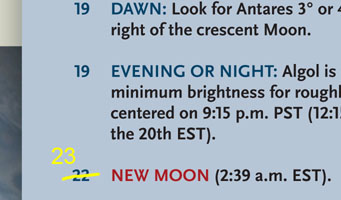 The editors of Sky & Telescope make every effort to provide accurate information, but errors do sometimes slip through. We correct all mistakes online as well as printing corrections in the magazine. So if you see something questionable in the magazine, check below to see if it's a known problem.
The editors of Sky & Telescope make every effort to provide accurate information, but errors do sometimes slip through. We correct all mistakes online as well as printing corrections in the magazine. So if you see something questionable in the magazine, check below to see if it's a known problem.
This article lists all known errors in issues of Sky & Telescope for 2012. See also the errata listings for other years.
January 2012
Page 8: The caption should read "Clarke Belt," not "Clark Belt."
Page 43: The Moon is new at 2:39 a.m. EST on January 23rd, not January 22nd. However, Algol's minimum is on January 22nd as stated.
Page 73: The list of scientists and explorers spurred on by the Venus transits should end with Jean-Baptiste Chappe d'Auteroche, not Claude Chappe. (Claude Chappe was only a few years old in 1769.)
In the sidebar "The Black Drop Effect," Hunter's drawings are from 1874, not 1876.
Page 74: In the map of visibility for Venus’s June transit, the region encompassing North America should be labeled “Transit in progress at sunset,” not sunrise. The map on page 70 of the article has the correct labels.
February 2012
Page 22: The labels for the Sgr B1 and Sgr B2 star-forming regions are reversed in the image of the Milky Way's central region.
Page 61: The image of NGC 1514 in the article "A Dozen Winter Planetaries" is mirror-reversed: north is up and east is right, which is also true of the original image at the NOAO website.
Page 69: In the timetable of the article “May’s Great Annular Eclipse,” the times for Arizona were wrongly corrected for Daylight Savings Time. (Arizona does not observe DST, although the Navajo Nation, which spans parts of Arizona, New Mexico, and Utah, does. The historical ins and outs of Arizona's clock are rather detailed.) Times listed for Arizona should be one hour earlier. You can also go to the map at eclipse.gsfc.nasa.gov to see predictions in Universal Time.
March 2012
Page 33: Simon Portegies Zwart’s institution is Leiden University in the Netherlands, not the University of Amsterdam.
Page 43: The image of Mars was taken in June 2001, not 2003 as the caption indicated.
April 2012
Page16: The caption of the planetary lineup at the page's top incorrectly states the exoplanets shown are in the Kepler-22 system; the planets are from the Kepler-20 system, as the labels indicate.
Page 29: In the shell diagram of Mercury's composition, Mercury’s core comprises the two yellow shells, not just the innermost sphere as the caption states.
Page 56: The planetary nebula Abell 33 is incorrectly labeled as Abell 31 on the star chart.
July 2012
Page 36: In "The Quest for Totality," the penguins surrounding Babak Tafreshi are king penguins, not emperor penguins.
In the same article, several images credited to David Makepeace should have either shared credit with other photographers or be credited solely to one of those photographers. Those images and credits are:
• page 37: PATAGONIA ECLIPSE: Lukas Gornisiewicz & David Makepeace; SOLAR VIEWER: L. Gornisiewicz; PATAGONIA ECLIPSE: L. Gornisiewicz & D. Makepeace
• page 40: MACHU PICCHU: Susan Sutherland
• page 41: TRUCK: L. Gornisiewicz; ECLIPSE: L. Gornisiewicz & D. Makepeace
Page 51: In the bottom zoom image of the R Draconis article, R Dra is the incredibly faint dot 1.5 mm below and left of the star indicated. The top image on the same page is correct.
November 2012
Page 46: In the chart "Sun and Planets, November 2012," the column that says "May" should say "Nov."
December 2012
Page 44: The observing note for the 25th should say the “nearly full Moon” instead of “just-past-full Moon.” The same goes for the note on page 49. The lunar phase dates listed on page 55 are correct.
 0
0

Comments
You must be logged in to post a comment.